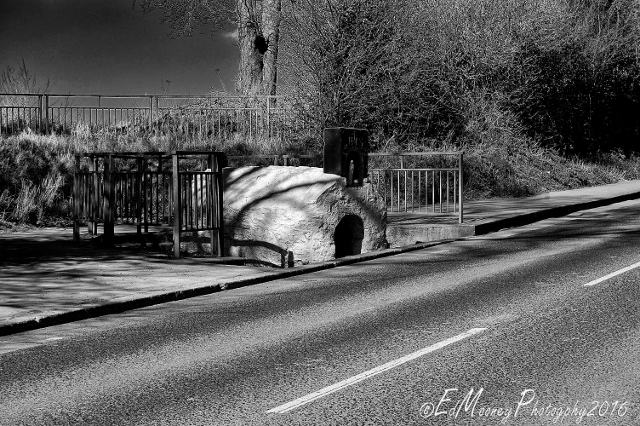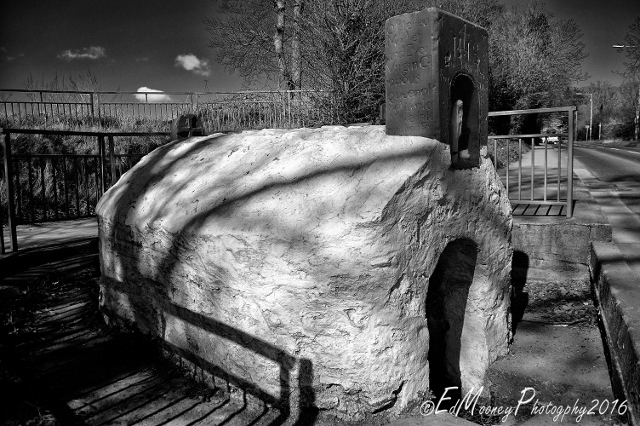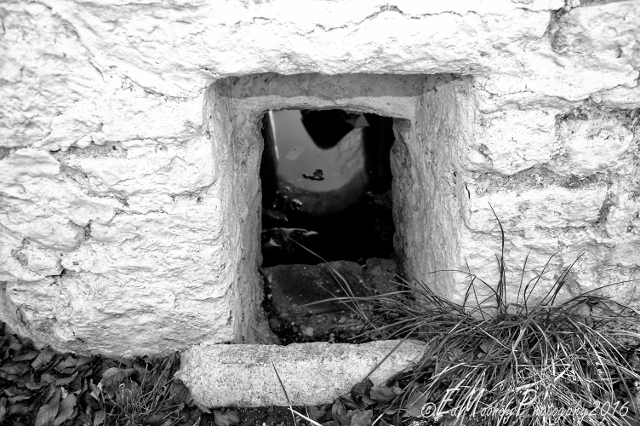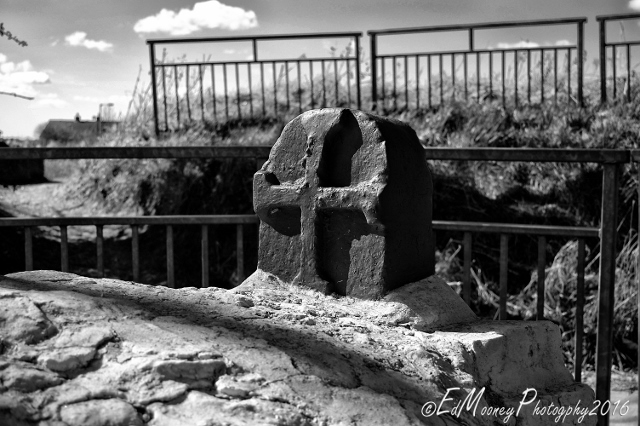Heading back up the bustling Church Street from the church of Mary in Mullhuddart, there is an interesting vaulted well-house. It was whilst out searching for this that I found the old Church Ruins of Mullach Eadrad from last weeks post. Situated right on the edge of the busy road, this is surely the strangest holy well that I have come across to date. In its day it was said to have been surrounded by trees in a grove effect which must have looked fantastic. Well over the years the peace and tranquillity of the grove has disappeared along with the trees and it is now surrounded by tonnes of concrete in the shape of paths. housing estates and a very busy road. The well has thankfully been recognised by Fingal County Council as ‘County Geological Site’ which probably explains why it hasn’t been knocked and replaced with a bicycle track or something.
The rubble stone corbelled roof structure surrounding the well dates back to around 1700,There is both a front and rear entrance. Entry to the well is via the stone stepson the roadside opening, but with all the surrounding concrete you would need to be a hobbit or leprechaun to walk inside. On the roof are two finials, one a stone carved with a cross in relief and the other a stone niche with an inscription. Like most holy wells, this was once probably a sacred spring for our ancient ancestors. With the coming of the new religion to our shores many of the sacred sites were Christianised, usually by associating them with a saint and changing festival/feast days to Christian ones, Christmas is probably the best known example of this.
The well at Mullhuddart is believed to have been quite popular during Norman times and was dedicated to the Virgin Mary, just like the old church a few meters up the road. During the eighteenth century large crowds were said to have gathered here on the 8th of September (Lady’s Day), the feast of the birth of the Virgin Mary, seeking a cure for whatever ailment they suffered from. It would seem that King Henry VI set up an order initially called the Order of the Guild of the Blessed Virgin Mary and provided them with a sum of money for the upkeep of Marian shrines in the area, but in particular for the upkeep of Our Lady’s Well. It was this order that erected a small ‘u’-shaped wall as an enclosure around the well and planted a number of trees to create the impression of a grove. After Henrys death the order seemed to disappear. After this the well and presumably the church came under the care of the nuns of Grace Dieu. The Grace Dieu nuns were an order of Augustinian canonesses dedicated to God, the Holy Trinity and Saint Mary founded by Rohese de Verdon in 1241.
Whilst this order did not last long in England, they managed to survive a little longer in Ireland. They capped stone roof with a chimney like stone front & rear is inscribed with various prayers to the Virgin and a small niche and an incised cross above. The well is kept in quite good condition, considering its close proximity to the adjacent busy road; unfortunately upon examining the interior of the well it would seem that the water source has become stagnant. Considering the many housing estates and industrial complexes in the surrounding area it is quite possible that over recent years the source has been damaged.
For these and more of my images, why not visit my Website











An interesting well, Ed, and brought to new life by your photos, and the historical information. You are continuing to do well, in your quest to be a ‘ruin-hunter.’
Best wishes, Pete.
LikeLiked by 2 people
Cheers Pete, most of these sites tend to be open wells, although this is one of the exceptions, I havent seen too many self contained springs like this. And on the edge of a road is a first for me.
LikeLike
It looks like someone cleaned it up recently. There are usually a number of rosaries and other offerings around the Virgin’s statue. Even the well, though stagnant, if frequently full of rubbish. Maybe those who have been abusing the site in the past have met with some comeuppance (I do like to imagine the karmic wheel making its rounds).
LikeLiked by 1 person
Karma can be a wonderful thing, unfortunatley sometimes it can be a bit slow coming round. The well itself seems to be a bit of a rubbish trap. Anything discarded from the street and passing card will inevitably end up there.
LikeLike
So sad that such things aren’t treated with more respect.
LikeLiked by 1 person
Thats the story of my life, One of my goals has always been to document as many of these places as I can. Unfortunately over the last two years I have lost out on a number of them.
LikeLiked by 1 person
That’s a really strange place for a sacred site, although one or two Cornish ones are a bit strange. It’s a pity the water has taken a turn for the worse, though.
LikeLiked by 1 person
It sure is John, looks like they just built around it. Strange I know, but better than building over it like so many other heritage sites. As with many of these ancient springs the water table usually becomes corrupted and then the site itself ends up collecting rubbish. They may once have had special properties, but these days you would most likely catch something nasty by drinking its waters.
LikeLike
Incredible to find something so historic and sacred in the middle of a modern concrete jungle. I find the juxtaposition amazing and something you wouldn’t see in North America. Do people passing by even realize what a treasure it is?
LikeLiked by 1 person
So true Darlene, my guess is probably not 😦
LikeLike
Reblogged this on Green Dragon's Cave, Author and Artist.
LikeLiked by 1 person
Thanks a mill Christy 🙂
LikeLiked by 1 person
Any time!
LikeLiked by 1 person
Great photos, great history, but such a sad sight to see, thinking of the place once being surrounded by trees and now by the side of the road. Truly thankful, though, that someone could relate what you have captured before (God forbid) it disappears forever from sight and memory.
LikeLiked by 1 person
Well I think it’s wonderful! It’s been preserved, well, kind of, when so many other holy Wells and sacred ancient sites are just forgotten about or destroyed. Its quite unique, and another great discovery. 😊
LikeLiked by 1 person
Thanks Ali, it is one of a kind alright 🙂
LikeLike
Another really interesting post! I am still waiting eagerly for the book… 🙂
LikeLiked by 1 person
Thanks Dan, good things shall come to those who wait. Its just not the right time yet, but I will continue to do the ground work for it 🙂
LikeLiked by 1 person
Hi Edward – Thanks for liking some of my photos. Always happy to find another photo-fiend. I’m quite into abandoned places myself – a little less historic than ruins in some cases but nonetheless similar – but haven’t posted many. But, after reading some of your posts and seeing how you clearly mix the past, present and future perhaps I’ll give some of mine a shot. Your photography is great! Clearly a passion. Haven’t been to Ireland yet but I’ll look forward to following your map one day. Cheers1
LikeLiked by 1 person
Thanks so much Tracey, It all kinda fell into place a few years ago, my main aim is to document as much as I can before it disappears but yes I am a bit of a photo fiend 🙂
I would love to see more of your images, especially ruins and ancient places. France should provide you with an equal amount of places to visit and explore 🙂
LikeLike
So good that you record these places. How do you research them?
LikeLiked by 1 person
Thank you Sherry, Its a long ardious process that can sometimes take longer than expected. I always start of with my field notes, then the National Monuments service is a good starting point. After that I have accuired numerous documents and books which I scour for history and facts. The various annals of Ireland are also great sources. Oh and more importantly, landowners and locals can be a great source for info and stories 🙂
LikeLiked by 1 person
I imagined you digging deep. I appreciate your hard work. I like knowing some of your sources. Thanks.
LikeLiked by 1 person
Thank you Sherry, the more I do it the deeper I enevitably find my research going. All Im short of doing is raiding the acedemic libraries. Although I cant see them giving a neophite such as myself access. I would probably have too go back to school and become a professor or something? 🙂
LikeLike
In NYC non professors can get passes for research in academic libraries. Give it a try and see if you csn. I did historic research for a geography report on parks and managed to get a pass into the huge NYU library.
LikeLiked by 1 person
Really, I must look into that. I guess there is no harm in asking is there:-)
LikeLiked by 1 person
P.s. I went to college late – in my 40s. It was drummed into me always to list all my sources. I know you probably don’t want to keep listing them all. Just had an idea, make a general source page and put a link to it at the bottom of your posts. If a special one is used for you could add that to the post. It would be a big plus to know your secrets 🙂 plus it’s the scolarly right thing to do
LikeLiked by 1 person
Lol, I always wondered about that? Nice idea though:-)
LikeLike
I guess that’s what happens as Mankind advances; we remove what was to make what is – so even though it seems out of place, thankfully someone recognised it and kept it there. Keep taking these photos!
LikeLike
Such a shame, for an advanced race we dont appear to be as clever as we think we are.
Thanks for the confidence and support 🙂
LikeLike
What a shame. Modern people living what they think is life. Wish that they would re open the source.
LikeLiked by 1 person
So true, chances are the original sourse has been destroyed or cemented in, such a shame
LikeLiked by 1 person
Unique, I hope it never gets taken down.
LikeLiked by 1 person
Touch wood, with fingers and toes crossed.
LikeLike
Great post as ever Ed. Is the pronunciation of this similar to Tobermory in Mull?
Secondly, I have linked your blog to mine today as I am thanking you for the Chicken and Jacket Potato idea… 😉
LikeLiked by 1 person
Beautiful photos with interesting historical context. Thanks for sharing this wonderful work.
LikeLiked by 1 person
My pleasure Don, glad you enjoyed it 🙂
LikeLiked by 1 person
As always so impressed with your shots. I am trying to take black and white shots. Ah the lighting.
LikeLiked by 1 person
Its tricky starting off, but keep at it it will come in time, experiment and get to know what works for you 🙂
LikeLike
I’ve never seen anything like this – so very cool!
LikeLiked by 1 person
Thanks a mill Sarah, so glad you liked them 🙂
LikeLike
Interesting find you got there Ed. I like these places most people walk by without a second thought. They have a secretive nature about them that makes us wonder about their history. Cheers for the post Ed.
LikeLiked by 1 person
My pleasure Andy, I get a huge kick out of finding, expiring and researching them.
LikeLiked by 1 person
What I like is that you get ‘out there’ and get your hands dirty. Love that element of exploration.
LikeLiked by 1 person
And sometimes a bit more than my hands 🙂 Once the camera stays clean, I’m cool 🙂
LikeLiked by 1 person
What a cute looking well….and I didn’t know that ‘tobar’ was used for wells outside of Scotland! Always learning💕
LikeLiked by 1 person
Thank you, well we do share a similar lingo 🙂
LikeLike